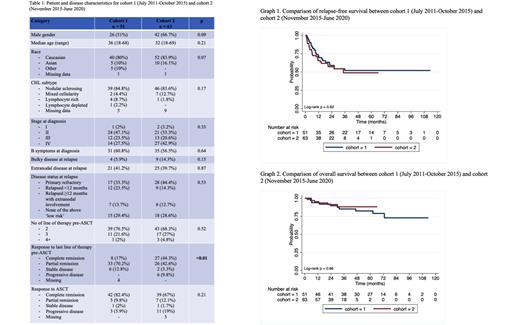Abstract
Introduction:
Patients newly diagnosed with classic Hodgkin lymphoma (CHL) have over 80% chance of remission with first-line chemotherapy, such as ABVD (adriamycin, bleomycin, vinblastine, dacarbazine) regime. However, 10-40% of patients relapse eventually and require salvage therapy. High-dose therapy with autologous stem cell transplantation (ASCT) remains the standard of care for patients with relapsed or refractory CHL, offering a cure rate of around 50%. This may be further improved to around 60% with post-transplant consolidation with brentuximab vedotin (BV). Post-SCT BV consolidation has been offered to all patients, regardless of the risk group, in British Columbia since late 2015. We set out to review the ASCT outcome in CHL patients in the recent decade at our institution.
Methods:
All adult patients who received ASCT for relapsed or refractory CHL between July 2011 and June 2020 were included in this retrospective analysis. Information pertaining to their demographics, disease characteristics, treatment history, transplant details, clinical outcomes and post-relapse therapy was obtained by review of electronic data. The data cut-off date was June 28, 2021. Survival outcomes were censored at the last known clinic visit for patients without relapse or death during follow up. Survival analysis was performed using Kaplan-Meier survival function and log-rank test. Pearson's chi-square test and ANOVA were used for comparison between cohorts. The statistical program used was Stata® version 16.1 (Texas, USA).
Results:
114 patients underwent ASCT for relapsed/refractory CHL. Bulky disease and extranodal involvement were seen in 11% and 40% respectively at relapse. Looking at the 'high risk criteria' as defined in the AETHERA trial: 45/114 (40%) patients had primary refractory CHL, 21/114 (18%) had relapsed within 12 months of completing the front-line chemotherapy and 15/114 (13%) had relapsed beyond one year of completing initial treatment but with an extranodal disease.
The most commonly used salvage chemotherapy regime was GDP (gemcitabine, dexamethasone, cisplatin; 111/114; 97%). 10/114 (9%) patients received BV after failing salvage chemotherapy pre-SCT. The median number of lines of therapy pre-SCT was two (range 2-5). 94/108 (98%) had a chemosensitive disease with 35/108 (32%) achieving complete remission. 6/108 (6%) patients had a progressive disease at the time of SCT. For the transplant, all patients had a peripheral blood stem cell source and the conditioning regime was either Carmustine/Etoposide/Cytarabine/Melphalan (76%) or Etoposide/Melphalan (24%).
After median follow up of 62.2 months, 50/114 (44%) patients relapsed with median relapse-free survival of 20.2 months (range 0.9 - 113.5) and 16/114 (14%) died. The direct cause of death was lymphoma progression in all but three patients (PJP pneumonia, pulmonary fibrosis, traumatic subdural hematoma).
Whereas only 4/51 (8%) patients (2 without relapse) received post-SCT BV consolidation via a compassionate access program between July 2011 and October 2015 (cohort 1), 45/63 (71%) patients (33 in remission) received routine BV consolidation between November 2015 and June 2020 (cohort 2). In cohort 2, 44% had primary refractory CHL compared to 33% in cohort 1 but the number of 'low risk' patients was similar at 29% (Table 1). The most common reason for no post-SCT BV consolidation in cohort 2 was patient refusal (7/18; 40%). Other causes included BV pre-SCT, early disease progression and patient comorbidities. Only 9/42 (21%) patients with available data in cohort 2 completed the planned 16 cycles of BV consolidation. The median number of cycles was 10.5 (range 1-16). The most common reasons for early termination of BV consolidation were peripheral neuropathy (22/33; 67%) and disease progression (9/33; 27%). There was no statistically significant difference in PFS or OS demonstrated between the two cohorts (Graphs 1, 2).
Conclusion:
After median follow up of 5 years, 86% of patients remain alive and 56% are alive in remission. In British Columbia, post-SCT BV consolidation has been widely adopted with over 70% of patients receiving at least one cycle since late 2015. Successful completion of post-SCT BV consolidation is, however, limited by a high rate of treatment-limiting peripheral neuropathy. Relapse-free survival benefit of routine post-SCT BV consolidation is not demonstrated in this single-centre cohort.
White: Novartis: Honoraria. Sutherland: Janssen: Consultancy, Research Funding; GSK: Research Funding; Karyopharm: Research Funding; Celgene: Consultancy; Amgen: Consultancy. Sanford: Abbvie: Membership on an entity's Board of Directors or advisory committees; Stellar: Membership on an entity's Board of Directors or advisory committees. Abou Mourad: Amgen: Consultancy; Paladin: Consultancy; Pfizer: Consultancy. Song: Amgen: Consultancy, Honoraria; Celgene: Consultancy, Honoraria, Research Funding; Janssen: Honoraria, Research Funding; Takeda: Consultancy, Honoraria; GlaxoSmithKline: Honoraria; Kite, a Gilead Company: Honoraria; Bristol Myers Squibb: Honoraria; Sanofi: Honoraria.


This feature is available to Subscribers Only
Sign In or Create an Account Close Modal